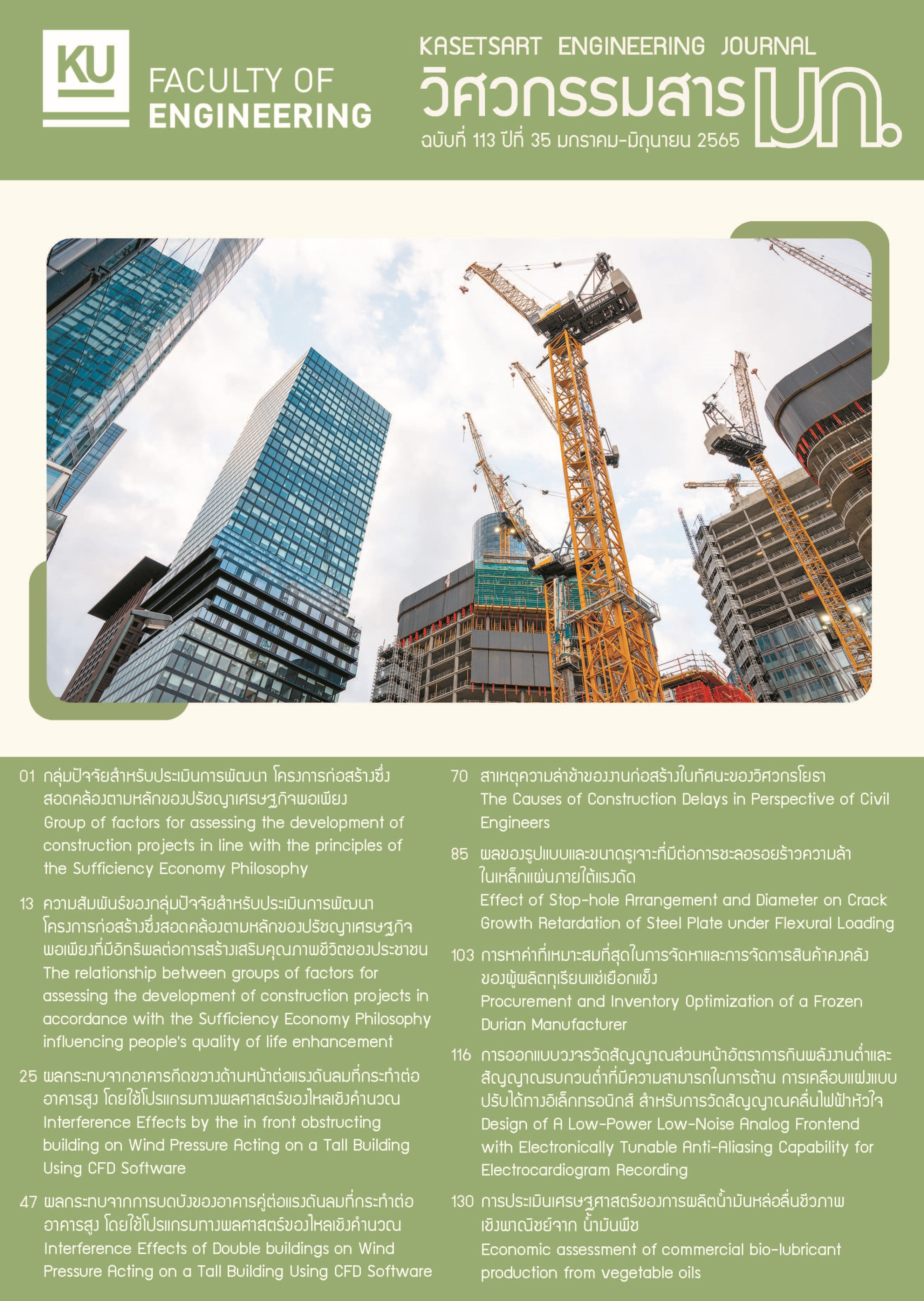Interference Effects by the in front obstructing building on Wind Pressure Acting on a Tall Building Using CFD Software
Keywords:
Wind load, high-rises building, computational fluid dynamics, base shear, base momentAbstract
The analysis of wind forces acting on a structure using Computational Fluid Dynamics (CFD) techniques is widely used in many countries to determine force and pressure coefficients, building top displacements, base shear and moment, surface pressure around the building, etc. This research was conducted using the CFD technique to study the wind effects on a tall building model according to the CARRC (Commonwealth Advisory Aeronautical Council) standard, including building responses in the along-wind and across-wind directions, to verify the applied software and analysis results. Additionally, the interference effects of an obstructing building on wind pressure acting on a tall building were studied. However, in Thailand, wind tunnel experiments are typically used to determine wind force acting on a building model, which is complex and requires expensive instruments. Furthermore, the wind tunnel test is not flexible for adjusting the model to study different experimental conditions and parameters. The accuracy of the analysis was verified by comparing the simulated results of a CFD model software with the results from wind tunnel experimental results of previous research. It was found that the pressure and force coefficients at the location of two-thirds height of the building were slightly different from the experimental results, about 7% and 11%, respectively. Nonetheless, the simulation results can be concluded to be in accordance with the vibration at the top of the building in both along-wind and across-wind directions. Regarding the study of interference effects by the obstructing building, it was found that, with the obstruct distance, u, less than 20, the closer the obstructing building was, the smaller the base shear of the main building could be observed. The same interference effect for the base moment of the main building can be observed since the reduced obstructing distance, u = x/L, is less than 17. Finally, a manual for performing CFD analysis using CFD commercial software for studying wind effects on a tall building has been prepared for further research. It is noted that the computer's performance is an important factor for the CFD analysis. With higher computer performance, more accurate simulation results and faster computation can be obtained.
References
Huang S, Li Q S, and Xu S (2007). Numerical evaluation of wind effects on a tall steel building by CFD. Journal of Constructional Steel Research, 63: 612–627.
Braun A L, and Awruch A M (2009). Aerodynamic and aeroelastic analyses on the CAARC standard tall building model using numerical simulation. Computers and Structures, 87: 564–581.
Obasaju E D (1992). Measurement of forces and base overturning moments on the CAARC tall building model in a simulated atmospheric boundary layer. Journal of Wind Engineering and Industrial Aerodynamics, 40: 103–126.
Thepmongkorn S (2004). High frequency force balance model tests for a prediction of wind-induced forces and responses of buildings. The 9th National Convention on Civil Engineering, Phetchaburi, pp.120-125.
Bairagi A K, and Dalui S K (2014). Optimization of Interference Effects on High-Rise Buildings for Different Wind Angle Using CFD Simulation. Electronic Journal of Structural Engineering, 14: 39-49.
Dalui S K, Kar R, and Hajra S (2015). Interference Effects on Octagonal Plan Shaped Tall building under Wind - A Case Study. SCIENTIFIC COOPERATIONS WORKSHOPS ON ENGINEERING BRANCHES, Istanbul.
Dagnew A K, and Bitsuamlak G T (2010). LES evaluation of wind pressures on a standard tall building with and without a neighboring building. The Fifth International Symposium on Computational Wind Engineering.
Dagnew A K, Bitsuamalk G T, and Merrick R (2009). Computational evaluation of wind pressures on tall buildings. 11th Americas Conference on Wind Engineering, San Juan.
Desai A K, Sevalia J K, and Vasanwala S A (2014). Wind Interference Effect on Tall Building. World Academy of Science, Engineering and Technology International Journal of Civil, Environmental, Structural, Construction and Architectural Engineering, 8: 656-662
Mittal A K, Ghosh D, Behera S, Siddiqui I A, and Dharmshaktu D S (2013). WIND FLOW SIMULATION IN THE VICINITY OF TALL BUILDINGS THROUGH CFD. The Eighth Asia-Pacific Conference on Wind Engineering, Chennai.
Kheyari P, and Dalui S K (2015). Estimation of Wind Load on a Tall Building under Interference Effects: A Case Study. Jordan Journal of Civil Engineering, 9.
Roy A K, Verma S K, Lather S, and Sooda M (2014). ABL airflow through CFD simulation on tall building of square plan shape. 7th National Conference on Wind Engineering, Patiala.
Commonwealth Advisory Aeronautical Research Council (CAARC). https://uia.org/s/or/en/1100046837
Downloads
Published
Issue
Section
License

This work is licensed under a Creative Commons Attribution-NonCommercial-NoDerivatives 4.0 International License.


